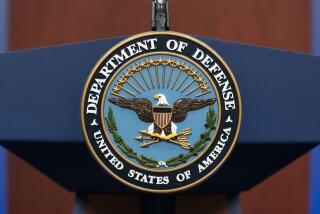U.S. Launching New-Look Military Strike Force
- Share via
SAN DIEGO — In another sign of what military officials call the “transformation” of the U.S. military, seven Navy ships are set to depart today for the western Pacific carrying 2,200 combat Marines, more than 100 Tomahawk missiles and a squadron of helicopters and vertical-lift Harrier attack planes.
While the U.S. routinely deploys task forces of troops, missiles and planes around the globe, what is being called Expeditionary Strike Group One combines ships, troops and weaponry in a way that breaks with recent Navy and Marine Corps tradition. More such groups are planned for both the Pacific and Atlantic fleets.
Defense Secretary Donald H. Rumsfeld has made transformation a top priority, with the goal of deploying U.S. forces closer to potential international hot spots with sufficient flexibility, firepower and troop strength to intimidate potential enemies or defeat them in combat.
For security reasons, military officials declined to pinpoint the destination of the strike group. But they noted that the Arabian Sea, Persian Gulf and Iraq are within the group’s “area of responsibility.”
The deployment is set to last eight months, two months longer than the average overseas deployment for Marines and sailors. Officials said the longer deployment is meant to compensate for forces spread thin by the Iraq war.
Included in the strike group are troop-carrying ships, a cruiser, a destroyer, a frigate and an attack submarine. The amphibious assault ship Peleliu will serve as the joint operations center for Navy and Marine brass.
The Navy has generally deployed its ships either in three-ship task forces carrying Marines or in aircraft carrier battle groups of seven to nine ships.
The expeditionary strike group is seen as combining the strengths of both approaches: the missiles from fast-moving ships that normally accompany an aircraft carrier, and the Marines and planes that would otherwise deploy as part of a slower-moving three-ship force.
Navy Cmdr. Louis Meier, battle group training coordinator for the San Diego-based Third Fleet, said the strike group concept is meant to enhance the “composite warfare system,” which is military jargon for having different military branches work more in tandem.
But for the approach to work, officials note, it will take a degree of cooperation among the services that is often difficult to obtain. The first strike group will be under the command of a Navy admiral, the next group may be headed by a Marine general.
For Strike Group One, the Marines are from the 13th Marine Expeditionary Unit based at Camp Pendleton, with ships from San Diego and Pearl Harbor. It will deploy more than 5,000 Marines and sailors.
Among the possible advantages to the strike-group configuration is that it would get a Marine force to a combat location faster by having Marines transfer to the faster-moving ships. Amphibious assault ships, the Marines’ normal mode of transit, are not known for speed.
“This is a big step for the Navy and Marine Corps,” said Marine Capt. Bill Pelletier, spokesman for the 13th Marine Expeditionary Unit. “We’ve had great success [with other configurations], but we want to experiment to see if we can do things better.”
The assignment of an attack submarine -- the Greeneville -- is an indication that despite the fact that the U.S. submarine fleet no longer faces a major adversary at sea, Navy officials believe submarines are necessary to launch Tomahawk missiles as well as to defend against submarines operated by Third World countries in coastal waters.
The Navy’s submarine strategy for decades involved preparing for a possible conflict in mid-ocean with the Soviet Union’s submarine fleet. As the post-Cold War Soviet sub fleet has dwindled, some critics charge that the U.S. submarine fleet is an expensive anachronism.
Navy officials, while reducing the number of submarines, insist that submarines are still needed as a defense against rogue nations that are buying and building submarines capable of operating in shallow waters in the Indian Ocean, Arabian Sea and Persian Gulf. A common plot of military-themed paperback novels involves terrorist groups using submarines.
More to Read
Sign up for Essential California
The most important California stories and recommendations in your inbox every morning.
You may occasionally receive promotional content from the Los Angeles Times.













